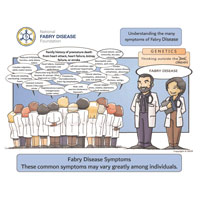Fabry Disease Kidney Symptoms
Chronic Kidney Disease (CKD) is common among individuals with classical Fabry disease and is one of the primary causes of premature death for these individuals, often at an early age. Prior to dialysis and kidney transplants, the average age of death for males with Fabry disease was considered to be about 41 years old. With dialysis and transplants, the average life-span increased to approximately 50 years old.
With the availability of Enzyme Replacement Therapy (ERT), the average life-span for males is thought to be considerably longer. Females with life-threatening complications of Fabry disease may also expect longer average life-expectancy with ERT.
According to studies, it is thought that as many as 2 to 4% of individuals with end-stage renal failure in the U.S. have Fabry disease as the underlying cause. Often, problems with kidney function lead to the diagnosis of Fabry disease, but while the Fabry disease diagnosis at this stage is a tremendous benefit, this is also a tragedy. The many other symptoms of Fabry disease, if recognized sooner, may lead to diagnosis and treatment earlier, possibly avoiding or inhibiting kidney decline.
CKD develops as a result of the progressive accumulation of lipids (primarily GL-3) in kidney cells. However, it is believed that progressive kidney damage may actually be more related to cell and tissue damage caused by lipid accumulation rather than the actual excess lipid accumulation/storage in the cells and tissues.
Many individuals with Fabry disease are not diagnosed until their kidney function declines beyond the point when management and treatment ideally would have begun. Through increased education and awareness efforts by the NFDF and others, the symptoms of Fabry disease must be recognized earlier to enable individuals to choose available management and treatment options prior to significant kidney decline.
Typically, beginning in the 30's in affected males and somewhat later for females that exhibit kidney function decline, disease impacts worsen which can result in:
- progressively reduced Glomerular Filtration Rate (GFR) and increased proteinuria associated with GL-3 accumulation
- long-term kidney dialysis is often required
- kidney transplants are not uncommon and are usually successful
- progressive kidney decline and failure occurs at a rate comparable to diabetic nephropathy
Periodic evaluation of kidney function should occur in every individual with Fabry disease, male and female, whether visible symptoms are present or not, and should include estimates of GFR, total protein, (micro)albumin excretion, and urinary sodium excretion.
Routine laboratory tests required to monitor kidney function include:
- kidney a Serum electrolytes
- creatinine
- BUN
- 24-hour urine or spot urine for total protein/creatinine
- albumin/creatinine
- sodium
- creatinine
- and GL-3 (optional)
ERT reduces the risk of progressive kidney decline in most individuals provided ERT is started before irreversible damage occurs. Based on current knowledge within the medical community, every male should be offered ERT.
Disease management primarily focuses on the control of blood pressure, lipids, and proteinuria. Angiotensin-converting enzyme (ACE) inhibitors and angiotensin receptor blockers (ARB) are important treatment options in avoiding additional kidney damage from proteinuria. The most important goals for concurrent therapy for individuals receiving ERT are stabilization of kidney function and reduction of urinary protein and albumin excretion to the absolute minimum, and not necessarily reduction of the systemic blood pressure to a preset goal. Individuals with Fabry disease may be unable to tolerate significant doses of ACE and ARB blood pressure medications even when the dose is increased slowly, in part because of the relatively low baseline blood pressures and substandard exercise tolerance in many individuals.
Note: The primary sources of this information are the September 2006 Genetics in Medicine journal article entitled "Fabry disease: Guidelines for the evaluation and management of multi-organ system involvement" and the expert opinion of the NFDF medical advisory board. Much of the information has been reworded, reducing the amount of medical terminology, to make it more readable for the general public.































Connect With Us